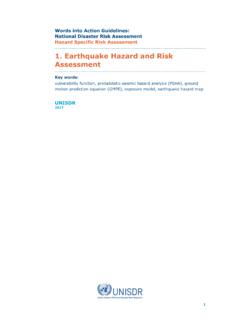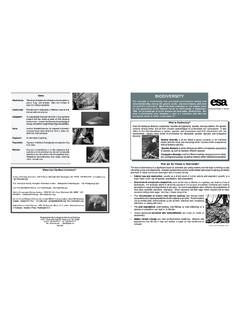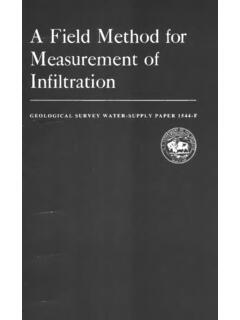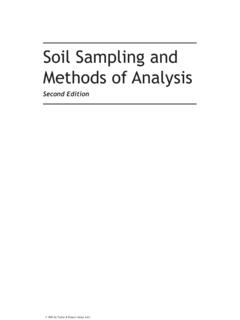Transcription of The Impact of Climate Change on Natural Disasters
1 21Z. Zommers and A. Singh (eds.), Reducing Disaster: Early Warning Systems for Climate Change , DOI , Springer Science+Business Media Dordrecht 2014 Abstract This chapter explains what hazards and Disasters are, reviews their trends, and assesses the potential Impact of changing Climate on hazards and extreme events. Observations since 1950 indicate increases in some forms of extreme weather events. The recent Special Report on Extreme Events and Disasters (SREX) by the Intergovernmental Panel on Climate Change (IPCC) predicts further increases in the twenty-fi rst century, including a growing frequency of heat waves, rising wind speed of tropical cyclones, and increasing intensity of droughts.
2 A one-in-20-years hottest day event is likely to occur every other year by the end of the twenty- fi rst century. Heavy precipitation events are also on the rise, potentially impacting the frequency of fl oods and almost certainly affecting landslides. This chapter also examines the science of event attribution, its potential and possible issues. It further outlines the global distribution and Impact of Natural Disasters . Keywords Climate Change Impact Natural hazards Disasters Event attribution Disaster risk distribution Tropical cyclone Chapter 2 The Impact of Climate Change on Natural Disasters Sandra Banholzer , James Kossin , and Simon Donner S.
3 Banholzer (*) S. Donner Department of Geography , University of British Columbia , 1984 West Mall , Vancouver , BC V6T 1Z2 , Canada e-mail: J. Kossin NOAA National Climatic Data Center , Asheville , NC , USA Cooperative Institute for Meteorological Satellite Studies , University of Wisconsin , Madison , WI , USA e-mail: Natural Hazards: What Are They? Disasters like Hurricane Sandy in October 2012 that affected the Caribbean and the East coast of america or fl oods in the summer 2010 that inundated large parts of Pakistan (see Figs.)
4 , , and ) dominated the media headlines around the Fig. Hurricane Sandy on October 28, 2012, on 1:45 pm eastern daylight time (Photo from NASA Earth Observatory image by Robert Simmon with data courtesy of the NASA/NOAA GOES project science team) Fig. Parts of New Jersey s shoreline before and after Hurricane Sandy hit late October in 2012. Storm surges and winds created a new inlet between the Atlantic Ocean and the Jones Tide Pond.
5 Sandy was the worst storm hitting the northeastern United States since the Great New England hurricane in 1938. Storm surges reached heights of up to 15+ feet in New Jersey (Munich 2013 ) (Photo from NOAA Remote Sensing Division) S. Banholzer et for weeks. These events had disastrous economic, environmental, and social consequences. Hurricane Sandy resulted in $50 billion economic losses, more than $25 billion insured losses, and led indirectly to power outages in 15 states (Munich 2013 ).
6 The fl ooding in Pakistan was considered the worst in a century killed over 1,600 people and left two million homeless (UN 2010 ). But what is the difference between a Natural hazard, an extreme event, and a disaster? Is a landslide in a deserted mountainous region a disaster? Questions like these require crystal-clear defi nitions of these terms. Fig. Northwestern Pakistan in August 2009 ( top ) and during the fl ooding in 2010 ( bottom ): Very strong monsoon rains caused the Indus River to inundate large areas and affecting 15 20 mil-lion people causing the worst fl ooding in a century.
7 This extreme event caused signifi cant damage, in particular to the agriculture sector as more than 6 million ha of agricultural land was inundated. Moreover, the productivity of this submerged land could be severely affected or even lost, causing a long-term Impact on the environment and the society (UN 2010 ) (Photo from UNEP 2010 ) 2 The Impact of Climate Change on Natural Hazards Versus Disasters The United Nations International Strategy for Disaster Reduction (UNISDR) released a compilation of updated standard terminology related to disaster risk reduction in order to mainstream terms and their defi nitions (UNISDR 2009a ).
8 See Box for a defi nition of hazard, Natural hazard, and disaster. There exist a variety of definitions for extreme events; the definition in Box is from the IPCC SREX report (IPCC 2012a ). The word extreme can be used to describe the Impact of the event or physical aspects of the event itself, which can lead to confusion. In general, extreme events, for example related with temperature or precipitation, can be defi ned by indices describing absolute quantities or the fre-quency of incidents beyond an absolute or relative threshold or by dimensionless indices (Zwiers et al.)
9 2013 ). Natural hazards and extreme events fall into the same context and can be used interchangeably. Disasters and Natural hazards/extreme events are often associated with each other but they are not the same. A disaster is the result of the severity of a Natural hazard combined with the exposure to the hazard, the preexisting vulnerability, and the inability to cope with the impacts of the hazard (UNISDR 2009a ). Examples of common hazards are hurricanes (Figs. and ), droughts, fl oods (Fig. ), and forest fi res (Fig.
10 Not every extreme event has to lead to a disaster; it largely depends on the pre-vailing conditions (IPCC 2012a ). The prevailing conditions are determined by the level of vulnerability and exposure of populations. Exposure and vulnerability are Box Defi nitions Hazard: A dangerous phenomenon, substance, human activity or condition that may cause loss of life, injury or other health impacts, property damage, loss of livelihoods and services, social and economic disruption, or environmental damage (UNISDR 2009a ) Natural hazard.









